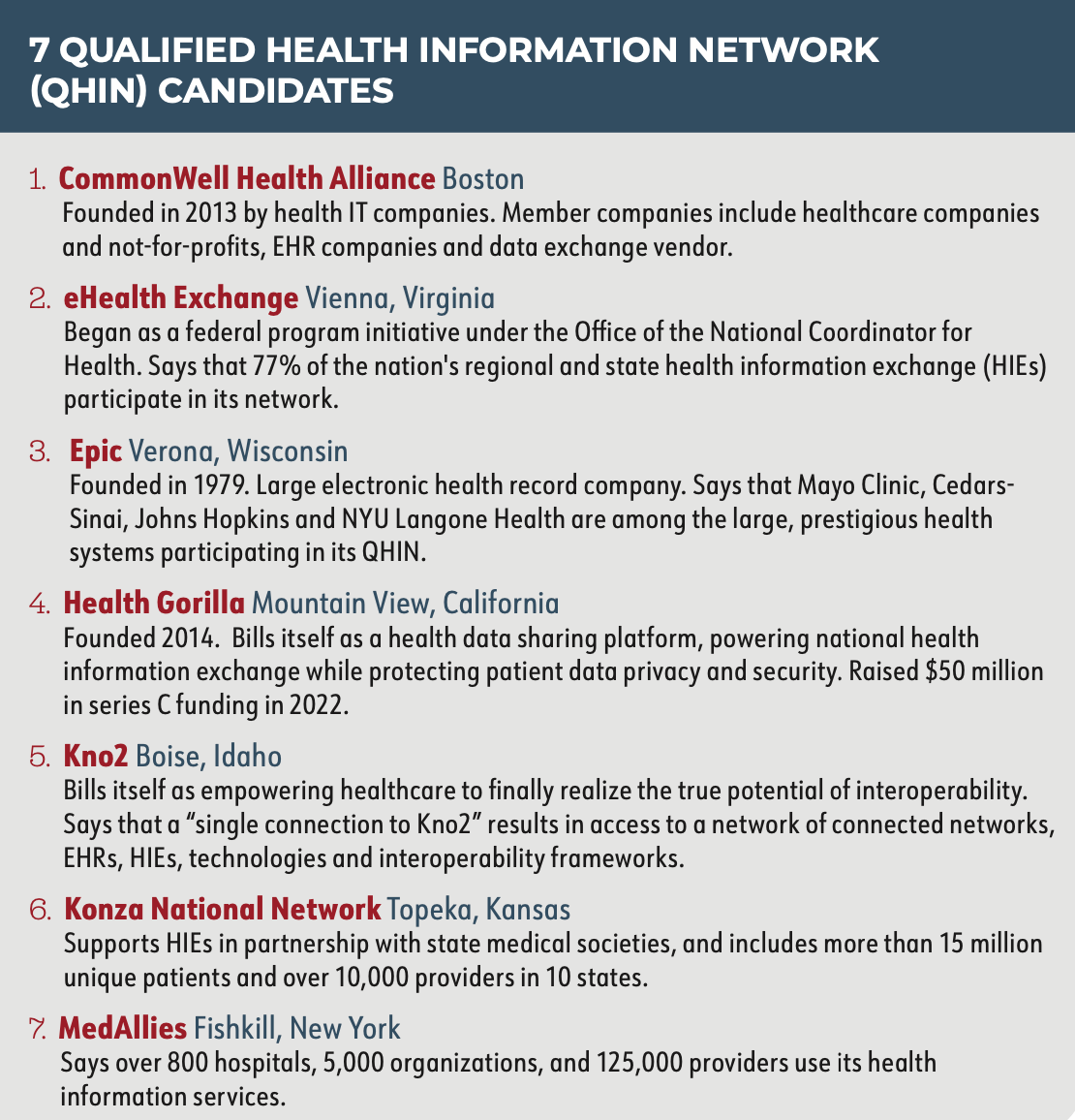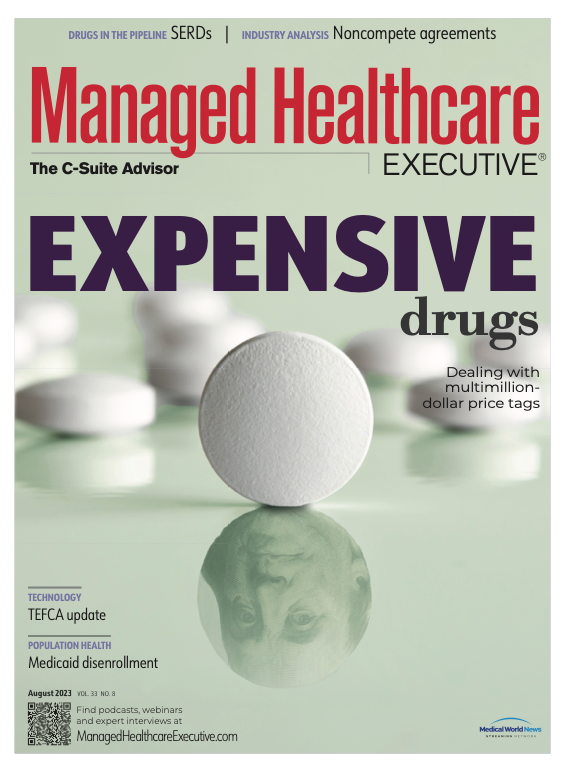- Drug Coverage
- Hypertrophic Cardiomyopathy (HCM)
- Vaccines: 2023 Year in Review
- Eyecare
- Urothelial Carcinoma
- Women's Health
- Hemophilia
- Heart Failure
- Vaccines
- Neonatal Care
- NSCLC
- Type II Inflammation
- Substance Use Disorder
- Gene Therapy
- Lung Cancer
- Spinal Muscular Atrophy
- HIV
- Post-Acute Care
- Liver Disease
- Pulmonary Arterial Hypertension
- Safety & Recalls
- Biologics
- Asthma
- Atrial Fibrillation
- Type I Diabetes
- RSV
- COVID-19
- Cardiovascular Diseases
- Breast Cancer
- Prescription Digital Therapeutics
- Reproductive Health
- The Improving Patient Access Podcast
- Blood Cancer
- Ulcerative Colitis
- Respiratory Conditions
- Multiple Sclerosis
- Digital Health
- Population Health
- Sleep Disorders
- Biosimilars
- Plaque Psoriasis
- Leukemia and Lymphoma
- Oncology
- Pediatrics
- Urology
- Obstetrics-Gynecology & Women's Health
- Opioids
- Solid Tumors
- Autoimmune Diseases
- Dermatology
- Diabetes
- Mental Health
As TEFCA Cohorts Take Shape, Stakeholders Now Must Show its Potential
Interoperability has been an aspiration in the healthcare IT world for many years. The finalization of new rules means they finally have a chance to prove its merits.
In the early weeks of the pandemic, the Centers for Disease Control and Prevention (CDC) asked states to start submitting COVID-19 case reports electronically.
In Kentucky, Brett Oliver, M.D., was eager to make the transition. “We were spending a lot of man-hours manually reporting all this,” says Oliver, the chief medical information officer at Baptist Health, a nine-hospital health system headquartered in Louisville.
Oliver and his colleagues embarked on a project to facilitate electronic reporting. It wasn’t easy, but they were able to get the job done in about six weeks. Then came the bad news: The CDC’s technology infrastructure would not support their data submissions.
“And you’re like, ‘Oh, my gosh,’” he said. “You’re just pulling your hair out.”
Oliver had run up against U.S. healthcare’s festering interoperability problem: He had data, the CDC wanted that data and yet for lack of a mutual framework, the exchange was noteasily completed.
‘Network of networks’
Such episodes may soon come to an end. In 2016, Congress passed the 21st Century Cures Act, which, among other things, instructed the Department of Health and Human Services (HHS) to develop a framework for the secure exchange of healthcare information.
Last year, HHS’ Office of the National Coordinator for Health Information Technology released the final draft of that framework, known as the Trusted Exchange Framework. Compliance with the framework is optional for now, but it represents what the agency believes to be “foundational principles” for the exchange of private health information. Along with the framework, it published a “common agreement” — a contract parties could enter into in order to ensure all parties followed the same procedures.
Collectively, the framework and the agreement are known as TEFCA (Trusted Exchange Framework and Common Agreement), pronounced “TEF-ka.” The goal is to create cohorts of healthcare stakeholders— known as qualified health information networks (QHINs) — who will work together to mutually implement TEFCA. The end result would be a “network of networks,” with the idea of healthcare data flowing freely — and securely — across them.
In February, HHS and The Sequoia Project, the nonprofit assigned to administer the program, announced the first six candidate QHINs the approved to move forward under TEFCA. A seventh, MedAllies, was added later. The groups now must launch their networks and, in doing so, test and problem-solve the new framework.

Matt Doyle, Epic’s interoperability software team lead, says interest in joining its cohort has been strong. In late May, the company announced an initial cohort of 22 members, but Doyle said the announcement prompted more systems to inquire about joining. As of early June, the cohort members spanned nearly 250 hospitals and 7,900 clinics. “It’s a very large footprint,” he says. “And we think that this is just the beginning.”
This is not Epic’s first foray into interoperability. The company launched its Care Everywhere program 15 years ago and it was one of the leaders of the interoperability framework Carequality. The latter now counts 70% of U.S. hospitals as its users, says Doyle. He calls such a high rate of usage “wonderfully positive.”
“On the other hand, that means about one-third (of hospitals) are still sitting on the sidelines,” he notes. “And one of the questions I spend a lot of time thinking about is how do we invite people off the sidelines to see the same benefits that their peers are already getting with interoperability?” Doyle hopes TEFCA will convince the nonadopters that interoperability is a coming reality, not a fantasy.
Still, it’s not just health systems that need to be on board for interoperability to meet its potential. Providers and their patients need to embrace the new capabilities made possible by interoperability.
Oliver, whose health system has joined Epic’s cohort, says he thinks providers continue to have apprehension, in part because some of the features of interoperability providers have seen thus far have been less than helpful. He points to CMS’ new rules requiring providers to be notified in a timely manner when their patient is admitted, discharged or transferred (ADT) to or from another facility. While he understands the premise, he says the reality is that providers get a flurry of notifications that are more of an annoyance than a help.
“From a provider’s perspective, it’s an absolute white-noise waste,” Oliver says, “because it doesn’t give you any clinical information.”
Another question is whether patients will take advantage of interoperability, whose theoretical goal is to give patientsgreater control over their healthcare data, sharing it easily with providers or other entities but still getting the privacy protections of the Health Insurance Portability and Accountability Act (HIPAA).
Doyle says the benefit of the TEFCA model is that patients can know that any entity that participates in a cohort will comply with HIPAA privacy and security rules, even if the entity is not required to. “An app that I install on my phone and use to access my own data isn’t covered by HIPAA,” he says. “But as a consumer, I have a heightened level of trust because I know that in this framework, they have voluntarily agreed to comply with those higher security privacy rules.”
But Oliver notes that some patients want to limit the availability of their health information even among HIPAA-covered entities. For instance, as state-level restrictions on abortions have been enacted, some patients travel out of state for abortions. Those patients may not want that healthcare information shared with their providers in their home states. Some patients may not want a specialist to have easy access to health data unrelated to the services the specialist is providing.
“That’s a very interesting space right now because there are people that are advocating for the patient to be able to say, ‘I want this sent and this sent, but not this, this and this,’” he says. Right now, the technology to do that is not available, but Oliver says it will be considered over the next several years.
A remaining question is how much the cohorts will cost. The Sequoia Project has not unveiled the cost structure for how interoperability-related costs will be shared among QHIN members. Doyle says embracing TEFCA will require buy-in from various stakeholders, both to educate patients and providers and to get them on board with utilizing interoperability to its full potential. “So everyone has a role to play,” he says, “... and everyone should be looking at how are we each going to advance interoperability?”
Jared Kaltwasser is a healthcare writer in Iowa. He is a regular contributor to Managed Healthcare Executive.

In the Scope of Virtual Health and the Future of “Website” Manner, Per Ateev Mehrotra
August 10th 2023Briana Contreras, an editor of Managed Healthcare Executive, had the pleasure of catching up with MHE Editorial Advisory Board Member, Ateev Mehrotra, MD, MPH, who is a professor of healthcare policy at Harvard Medical School and an Associate Professor of Medicine and Hospitalist at Beth Israel Deaconess Medical Center.
Listen
